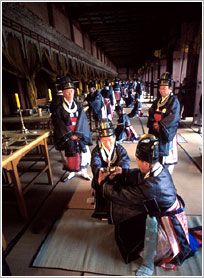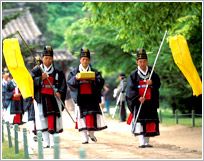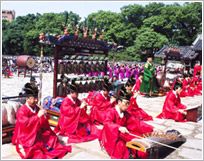 |
Jongmyo Jerye was one of the five kinds of rites performed by the Joseon Dynasty's royal family. The five were classified as gillye (auspicious rites), hyungnye (funural rites), binnye (reception ceremonies), gunne (military rites), and garye (wedding ceremonies). The gillye includes the ritual service to the gods of heaven and earth and royal ancestral spirits. Besides the rite worshipping the royal ancestors, Jongmyo Jerye has also been dedicated to meritorious civil and military retainers.
It was classified into regular and extraordinary ceremonies. The regular ceremony was held in January, April, July, and October. Initially, an extraordinary ceremony was held when auspicious occasions and national disasters occurred, but after the liberation from Japanese imperialist rule, it was held on the first Sunday of May. As it was a model of all ceremonies for spirits, its order and procedures were very strict and solemn.
 |
 |
The music, which was initially created in the reign of the Joseon Dynasty's 4th King, King Sejong, was used in royal palace banquets, and then it was modified as suitable for the ceremony under Sejo's reign, which has been handed down to present. The music was performed in Jongmyodaejae, which was discontinued in 1946 and then resumed in 1971, on the first Sunday of May every year.
Jongmyo Jeryeak performed in Jongmyo Shrine consists of Botaepyeong, which has 11 music pieces, and Jeongdaeeop, which also has 11 music pieces. The musicians are divided into the upper terrace orchestra in the foreground, called the Deungga, and the lower terrace orchestra, called the Heonga. Some music pieces of Jongmyo Jeryeak have their roots in the Tang Dynasty and Song Dynasty of China, and some grew in the native environment. These three different styles of music pieces are played with different instrumental ensembles.
Line dances are performed to the orchestral accompaniment of Deungga or Heonga in accordance with ritual procedures. Line dances aim at delineating the harmony of the negative and positive cosmic forces of yin and yang while they shift between civil dance(Munmu), delineating the positive force of yang to praise the civil achievements of the Joseon kings, and military dance(Mumu), delineating the nature of negative force of yin to praise the military achievements of the Joseon kings, for which the hand-held props are changed appropriately.
Hundreds of officiants, musicians, dancers, and attendants all create the ensemble of this composite art reflecting solemnity and magnificence typical of Asia. That this original property has continued without impairment for 500 years makes it indeed rare, so that its value should be preserved as part of the world's intangible cultural heritage and its benefits should be shared with a broad range of people worldwide.
Jongmyo Jeryeak, Important Intangible Cultural Properties No. 1, was selected as 'Masterpieces of the Oral and Intangible Heritage of Humanity,' with Jongmyo Jerye, Important Intangible Cultural Properties No. 56.
Source : visitkorea.or.kr


No comments:
Post a Comment